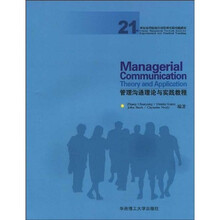管理沟通理论与实践教程

目 录内容简介
Chapter 1 Role of Communication in Business Organizatio
1.1 Warm-up Exercise
1.2 Key Concepts
1.2.1 What Is Managerial Communication
1.2.2 Overview of Theories in Managerial Communication
1.2.3 Types of Communication
1.3 Chapter Review
1.4 Application: The Crisis of an Iurance Company
Chapter 2 The Managerial Communication Process
2.1 Warm-up Exercise
2.2 Key Concepts
2.2.1 Levels of Managerial Communication
2.2.2 Basic Elements of Communication
2.2.3 Basic Communication Principles
2.2.4 Managerial Communication and Organizational Socialization
2.2.5 Barrie to Effective Communication
2.2.6 Strategies for Effective Communication
2.3 Chapter Review
2.4 Application: The Dilemma of a Female Colleague
Chapter 3 Intra-organizational Communication
3.1 Warm-up Exercise
3.2 Key Concepts
3.2.1 Definition of Intra-organizational Communication
3.2.2 Communication Flows and Networks in an Organization
3.2.3 Barrie to Effective Internal Communication
3.2.4 Improving Internal Communication
3.3 Chapter Review
3.4 Application: Ⅰ.A Division Manager's Issues
Ⅱ.Christmas Orde
Chapter 4 Inter-organizational Communication
4.1 Warm-up Exercise
4.2 Key Concepts
4.2.1 Organizational Environment and Inter-organizational Communication
4.2.2 Maintaining Good Inter-organizational Relatiohips
4.2.3 Boosting Organizational Image
4.2.4 Providing Customer Services
4.3 Chapter Review
4.4 Application : Singan Supermarket
Chapter 5 Interpeonal Communication
5.1 Warm-up Exercise
5.2 Key Concepts
5.2.I Definition of Interpeonal Communication
5.2.2 Issues in Interpeonal Communication
5.2.3 Communication and Conflict
5.2.4 Strategies for Building Harmonious Workplace Relatiohips
5.3 Chapter Review
5.4 Application: Yuri's Dilemma
Chapter 6 Intercultural Communication
6.1 Warm-up Exercise
6.2 Key Concepts
6.2.1 Intercultural and the Myths of Intercultural Communication
6.2.2 What Is Culture
6.2.3 Cultural Differences
6.2.4 Characteristics of an Effective Intercultural Communicator
6.3 Chapter Review
6.4 Application: Expatriate Training Challenge
Chapter 7 Managerial Listening
7.1 Warm-up Exercise
7.2 Key Concepts
7.2.1 Benefits of Listening
7.2.2 Barrie to Listening
7.2.3 Techniques for Effective Listening
7.3 Chapter Review
7.4 Application : Listening-Skill Training Exercise
Chapter 8 Memos
8.1 Warm-up Exercise
8.2 Key Concepts
8.2.1 Memos vs Lette
8.2.2 What Is a Good Memo
8.2.3 Writing Process
8.2.4 AMemoModel
8.3 Chapter Review
8.4 Application : Memo Writing Exercises
Chapter 9 Reports
9.1 Warm-up Exercise
9.2 Key Concepts
9.2.1 Types of Reports
9.2.2 Rules for Writing a Report
9.2.3 Elements of Memo Reports
9.2.4 Elements of Formal Reports
9.3 Chapter Review
9.4 Application : Report Writing Exercises
Chapter 10 Oral Presentatio
10.1 Warm-up Exercise
10.2 Key Concepts
10.2.1 Presentation Problems
10.2.2 Preparing a Presentation
10.2.3 Delivering Presentatio
10.3 Chapter Review
10.4 Application : Haler Group
Chapter 11 Conducting Interviews
11.1 Warm-up Exercise
11.2 Key Concepts
11.2.1 What Is Interviewing
11.2.2 Barrie in the Interview Process
11.2.3 Effective Interviewing on the Part of Interviewer
11.2.4 Effective Interviewing on the Part of Interviewee
11.3 Chapter Review
11.4 Application: Tom Smith and His Interview
1.1 Warm-up Exercise
1.2 Key Concepts
1.2.1 What Is Managerial Communication
1.2.2 Overview of Theories in Managerial Communication
1.2.3 Types of Communication
1.3 Chapter Review
1.4 Application: The Crisis of an Iurance Company
Chapter 2 The Managerial Communication Process
2.1 Warm-up Exercise
2.2 Key Concepts
2.2.1 Levels of Managerial Communication
2.2.2 Basic Elements of Communication
2.2.3 Basic Communication Principles
2.2.4 Managerial Communication and Organizational Socialization
2.2.5 Barrie to Effective Communication
2.2.6 Strategies for Effective Communication
2.3 Chapter Review
2.4 Application: The Dilemma of a Female Colleague
Chapter 3 Intra-organizational Communication
3.1 Warm-up Exercise
3.2 Key Concepts
3.2.1 Definition of Intra-organizational Communication
3.2.2 Communication Flows and Networks in an Organization
3.2.3 Barrie to Effective Internal Communication
3.2.4 Improving Internal Communication
3.3 Chapter Review
3.4 Application: Ⅰ.A Division Manager's Issues
Ⅱ.Christmas Orde
Chapter 4 Inter-organizational Communication
4.1 Warm-up Exercise
4.2 Key Concepts
4.2.1 Organizational Environment and Inter-organizational Communication
4.2.2 Maintaining Good Inter-organizational Relatiohips
4.2.3 Boosting Organizational Image
4.2.4 Providing Customer Services
4.3 Chapter Review
4.4 Application : Singan Supermarket
Chapter 5 Interpeonal Communication
5.1 Warm-up Exercise
5.2 Key Concepts
5.2.I Definition of Interpeonal Communication
5.2.2 Issues in Interpeonal Communication
5.2.3 Communication and Conflict
5.2.4 Strategies for Building Harmonious Workplace Relatiohips
5.3 Chapter Review
5.4 Application: Yuri's Dilemma
Chapter 6 Intercultural Communication
6.1 Warm-up Exercise
6.2 Key Concepts
6.2.1 Intercultural and the Myths of Intercultural Communication
6.2.2 What Is Culture
6.2.3 Cultural Differences
6.2.4 Characteristics of an Effective Intercultural Communicator
6.3 Chapter Review
6.4 Application: Expatriate Training Challenge
Chapter 7 Managerial Listening
7.1 Warm-up Exercise
7.2 Key Concepts
7.2.1 Benefits of Listening
7.2.2 Barrie to Listening
7.2.3 Techniques for Effective Listening
7.3 Chapter Review
7.4 Application : Listening-Skill Training Exercise
Chapter 8 Memos
8.1 Warm-up Exercise
8.2 Key Concepts
8.2.1 Memos vs Lette
8.2.2 What Is a Good Memo
8.2.3 Writing Process
8.2.4 AMemoModel
8.3 Chapter Review
8.4 Application : Memo Writing Exercises
Chapter 9 Reports
9.1 Warm-up Exercise
9.2 Key Concepts
9.2.1 Types of Reports
9.2.2 Rules for Writing a Report
9.2.3 Elements of Memo Reports
9.2.4 Elements of Formal Reports
9.3 Chapter Review
9.4 Application : Report Writing Exercises
Chapter 10 Oral Presentatio
10.1 Warm-up Exercise
10.2 Key Concepts
10.2.1 Presentation Problems
10.2.2 Preparing a Presentation
10.2.3 Delivering Presentatio
10.3 Chapter Review
10.4 Application : Haler Group
Chapter 11 Conducting Interviews
11.1 Warm-up Exercise
11.2 Key Concepts
11.2.1 What Is Interviewing
11.2.2 Barrie in the Interview Process
11.2.3 Effective Interviewing on the Part of Interviewer
11.2.4 Effective Interviewing on the Part of Interviewee
11.3 Chapter Review
11.4 Application: Tom Smith and His Interview
目 录内容简介
实验中心从培养经营管理类学生的动手能力、沟通能力、研究能力和创造性思维出发,率先提出从传统经管课程中“固化”出实验实践课程的思路,这是一种对传统教学模式的突破。
在自然科学、工程、农业和医药等领域,实验是经常需要进行的活动,相应学科的教学中都设有实验课程。但是在像经济、管理、社会等领域,由于涉及人的主观因素和复杂的社会条件,不可控因素过多,再加上规模和成本、安全和道德等原因,无法进行像自然科学和工农医等领域中的实验。但是随着信息学科与系统学科的发展,仿真技术不但进入了理工农医学科,也进入了经济、管理等学科,可以认为是一种广义的实验。
在自然科学、工程、农业和医药等领域,实验是经常需要进行的活动,相应学科的教学中都设有实验课程。但是在像经济、管理、社会等领域,由于涉及人的主观因素和复杂的社会条件,不可控因素过多,再加上规模和成本、安全和道德等原因,无法进行像自然科学和工农医等领域中的实验。但是随着信息学科与系统学科的发展,仿真技术不但进入了理工农医学科,也进入了经济、管理等学科,可以认为是一种广义的实验。
比价列表
公众号、微信群
 缺书网
缺书网微信公众号
 扫码进群
扫码进群实时获取购书优惠





